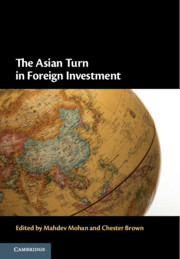Book contents
- The Asian Turn in Foreign Investment
- The Asian Turn in Foreign Investment
- Copyright page
- Contents
- Figures
- Tables
- Contributors
- Acknowledgements
- Table of Cases
- Table of Treaties
- Abbreviations
- Part I Introduction
- Part II National Approaches within Asia to the Regulation and Protection of Foreign Investment
- Part III The Rebalancing of Regulatory Space and Investor Protection in Asia
- 7 Regulatory Power and Investors’ Interests
- 8 Investment Agreements and Regulatory Space in Indonesia
- 9 Regulation of Foreign Investments in India
- 10 The Regulation of Foreign Investments in Sri Lanka
- Part IV Multilateral Rule-Making in Asia on Trade and Investment: From ASEAN to the Comprehensive and Progressive Agreement for Trans-Pacific Partnership
- Part V Emerging Issues
- Part VI What Lies Ahead?
- Index
10 - The Regulation of Foreign Investments in Sri Lanka
A Policy-Based Perspective
from Part III - The Rebalancing of Regulatory Space and Investor Protection in Asia
Published online by Cambridge University Press: 13 August 2021
- The Asian Turn in Foreign Investment
- The Asian Turn in Foreign Investment
- Copyright page
- Contents
- Figures
- Tables
- Contributors
- Acknowledgements
- Table of Cases
- Table of Treaties
- Abbreviations
- Part I Introduction
- Part II National Approaches within Asia to the Regulation and Protection of Foreign Investment
- Part III The Rebalancing of Regulatory Space and Investor Protection in Asia
- 7 Regulatory Power and Investors’ Interests
- 8 Investment Agreements and Regulatory Space in Indonesia
- 9 Regulation of Foreign Investments in India
- 10 The Regulation of Foreign Investments in Sri Lanka
- Part IV Multilateral Rule-Making in Asia on Trade and Investment: From ASEAN to the Comprehensive and Progressive Agreement for Trans-Pacific Partnership
- Part V Emerging Issues
- Part VI What Lies Ahead?
- Index
Summary
Sri Lanka’s adoption of an open economy in the late 1970s led to it hosting foreign investment projects, regulated by investment treaties. However, decades of civil strife and more recently, competition from regional neighbours, have resulted in the dividends of foreign investment being much lower than originally anticipated. In addition, negative experiences in dispute resolution fora found the state paying compensatory sums that often far outweighed the projected benefits of the investment. Its once prized strategic location has become a double-edged sword, as regional superpowers vie for investment opportunities that yield security benefits in the Indian Ocean rather than other investment needed by Sri Lanka.Against this backdrop, this chapter analyses the Sri Lankan experience of foreign investment by assessing the political background to foreign investment and associated legal developments and the state’s treatment of investors, including via dispute resolution. Using examples from comparative jurisdictions, it assesses policy and legal measures that could enable Sri Lanka to be seen as a worthwhile commercial prospect by diverse actors, and not only as a strategic move by regional powers. The authors argue in favour of shifting from a ‘leader-driven’ model to a more holistic and rules-based approach, and outline a multi-step plan of appropriate political and legal measures.
Keywords
- Type
- Chapter
- Information
- The Asian Turn in Foreign Investment , pp. 160 - 180Publisher: Cambridge University PressPrint publication year: 2021

